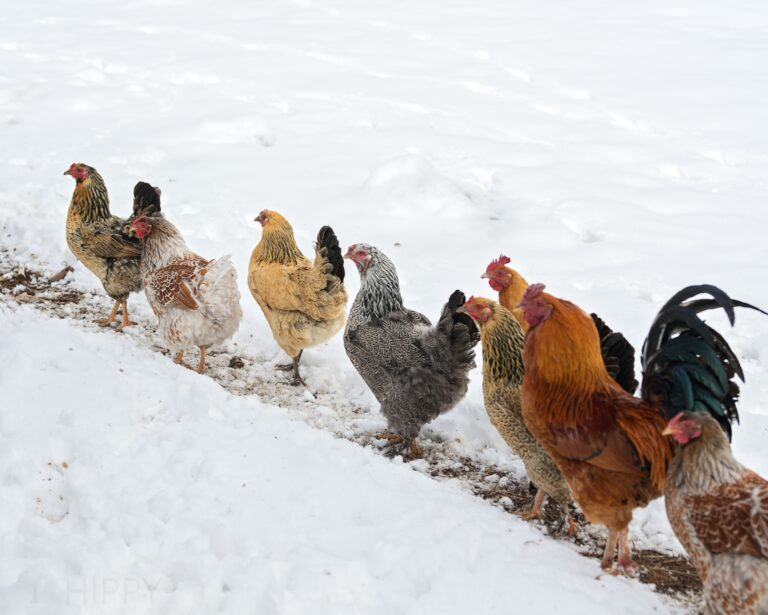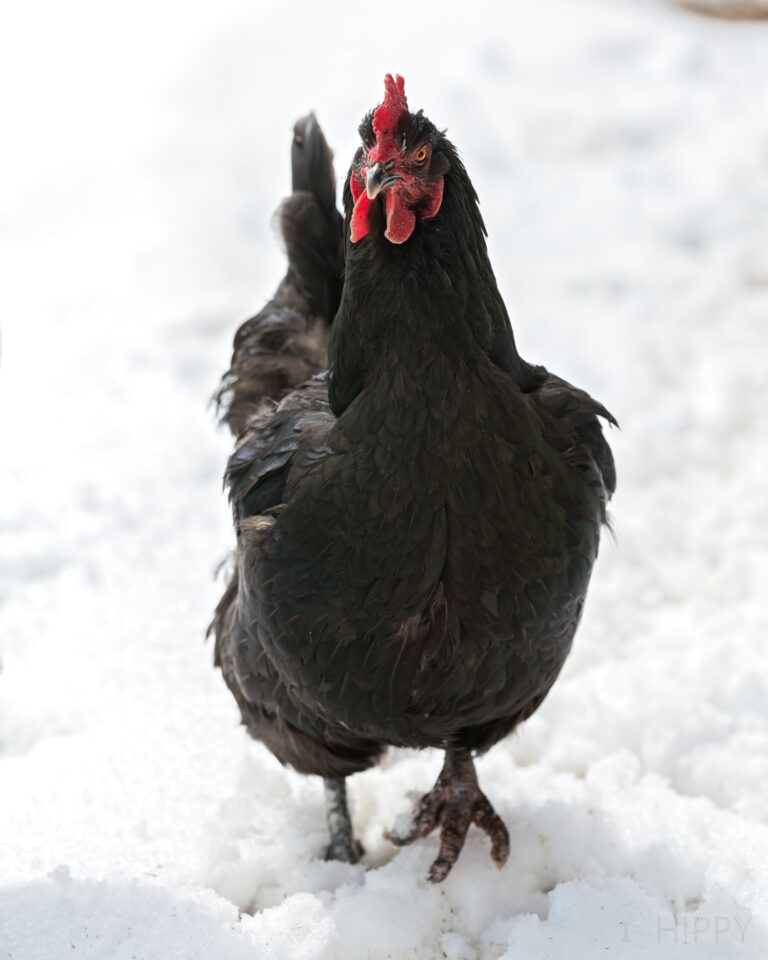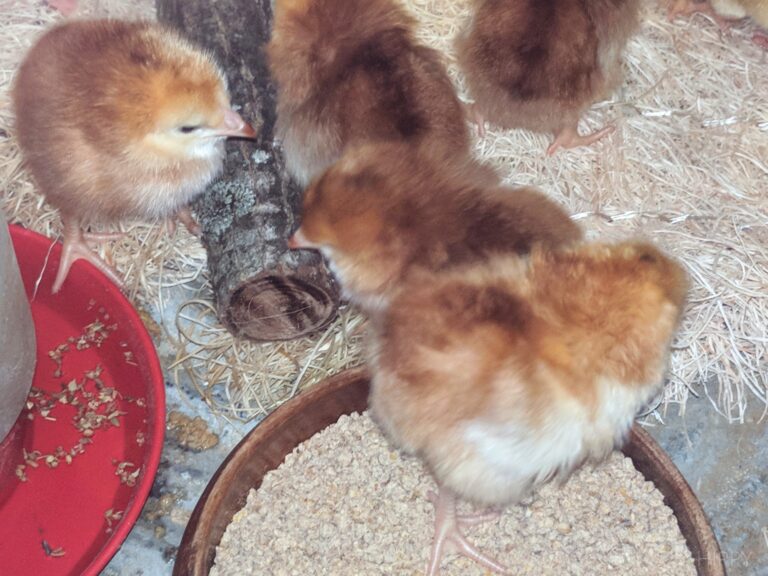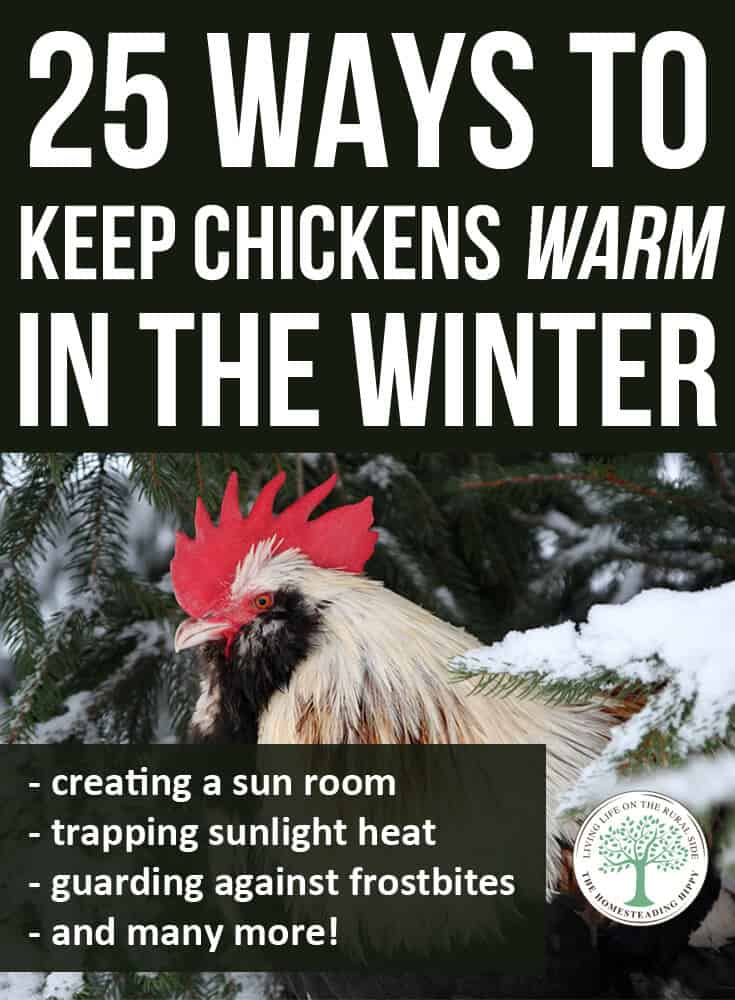If you have ever thought about raising chickens, you likely have images of ruby-red birds prancing through grass-covered pastures running through your head.
The unfortunate reality for many people is that for part of the year, those grass-covered pastures are covered with something else entirely – snow.

Raising chickens for eggs or meat requires you to think carefully about what you will do with your birds during the colder winter months.
While chickens can, for the most part, survive just fine in the snow and ice, super cold temperatures (or moderately cold temperatures paired with wet weather) can spell disaster for your birds.
As a result, you need to think of some creative ways to keep your chickens warm in the winter. Don’t have electricity? You need to get even more creative.
Here are some tips to help you get the “winterization” process started.
Table of Contents
Do a Fall Clean Out
Each fall, do a thorough walk-through and clean out of your chicken coop. Clean it out, sweep out the cobwebs, and sterilize everything. This way, you can start the winter season off fresh.
As you clean, look for any damage. Not only will this invite cold air and snow into your coop, but it’s also a potential gateway for predators.
Rethink Your Location
If your chicken coop is already built and stationary, you don’t have a lot of options here. However, if your coop is movable or hasn’t been constructed yet, position it with the weather in mind.
If you can, put the coop in a protected location where bitter winds won’t slice right through. You might also consider putting it in a spot where the chickens will be able to warm up with the afternoon sun.
Whenever possible, try to build your coop up and off the ground. This can help your chickens stay warm by huddling together without the cold from the ground reaching up and chilling them to the bone.
Downsize
Have a large coop? You might want to rethink that. You don’t need to rebuild from scratch, either. The problem with a large coop is that the ceiling is going to be taller.
Heat rises, so as your coop gets larger, you lose more heat. Instead, opt for a smaller coop, ideally one where the roost bars are within two feet of the ceiling.
Keeping your roost bars close to the ceiling will allow your chickens to huddle together and generate more heat, without losing heat to the rafters.
Bed the Coop with the Deep Litter Method
Make sure you have deep litter bedding inside the coop. Deep, loose litter is going to be better than compacted litter – start by adding three to four inches of bedding.
Pick a nice, insulating material like wood shavings or straw. Each week, add a bit more litter and don’t worry about scraping out the old stuff.
Instead, add more litter and toss a few handfuls of scratch grain into the coop. The chickens will work to peck and scratch at the grain, at the same time helping to turn the bedding and make it decompose with the extra aeration.
In the spring, you can clean it out and you’ll have compost ready to go for your spring planting in the garden!
Check the Width of Your Roost Bars
Make sure your roost bars are nice and wide. The reason for this is that chickens need to be able to cover their feet with their bodies in order to protect themselves from frostbite. 2×4 is the perfect width because the chickens can sleep flat-footed.
Cozy Up Your Nest Boxes
In the winter – as with all seasons of the year, but doubly so in the winter – you need to make sure your nest boxes are filled with plenty of bedding. This doesn’t only prevent broken or eaten eggs, but it also helps keep things warm and cozy.
You should also consider hanging a few curtains in front of the boxes. This will help prevent the eggs from freezing, which is a common occurrence in cold weather.
Insulate Your Coop – But Not Too Much
A coop needs to be well insulated in order to keep your chickens warm. Add a bit of extra insulation with things like tarps or foam boards. However, don’t board things up too tightly – ventilation will help prevent the chickens’ combs and wattles from developing frostbite, which needs moisture in order to occur.
Vents should be located near the top of the coop, where cold air won’t flow directly onto your birds and create a draft.
These upper vents will allow warm, humid air to flow out of the coop and cool, dry air to flow in. It will keep the humidity down and prevent mold growth, too.
The best situation is to have a mesh screen with a hatch. This hatch will allow you to open and close the vent during the day and to close it up when it’s colder at night – or when it’s snowing.
Trap Heat with Sunlight
Days are short in the winter, but you can use sunlight to your advantage nevertheless. Add some well-insulated windows, which can act as a trap for the sun (this is especially true if you have a dark floor or are making use of the deep litter method!).
Trapping sunlight and increasing the amount of “thermal mass” that your coop captures will let it retain heat for longer. Compost, stone, and concrete floors will gather heat during the day and then release it slowly overnight.
Minimize Drafts
Just as your coop needs to be somewhat insulated, you need to make sure you minimize drafts. Wind chill can rapidly increase the rate that heat is lost from your coop. Make sure any air leaks are sealed up and that any rotten pieces of wood are quickly replaced.
If you find holes, the easiest and least expensive way to repair them is to screw a piece of plywood over them. This will prevent temperatures in your coop from dropping too quickly.
Supplement the Feed
Chickens need a little extra nutrition during the cold winter months. If you are expecting a super chilly cold snap, consider adding some extra calories.
Either utilize an auto feeder so that your chickens can help themselves to food throughout the day or consider feeding several times a day to increase their body warmth.
It’s extra imperative that you add extra feed in the evening to encourage digestion and increase body warmth during the night. Cracked corn or scratch grain is perfect for this – but make sure you feed these foods only at night.
This way, you can ensure that your chickens get all of their necessary nutrition from their feed during the day, with the corn or scratch serving as bonus treats after a long, cold day.
Some people even feed their chickens things like hot oatmeal or warm mash at night. This can really help stimulate their appetites if it seems as though they aren’t eating as much!
Mind the Water
Just as chickens need adequate nutrition during the winter months, they also need good hydration. Bring your chickens nice, warm water two times a day if you don’t have a heated waterer.
Keep in mind that heated waterers do take electricity to operate, but that doesn’t mean you need electricity wired into your coop. You can always run a heavy-duty extension cord (one rated for outdoor use) out to your coop for supplemental electricity.

Create a Barrier
Consider putting a few bales of straw in front of the doors in your coop. The straw bales will help insulate the coop a little bit more, and will also give them a spot to get up and off the floor on drafty days.
Don’t have access to straw bales? That’s ok! Other ways to keep your hens warm in cold climates include Styrofoam sheets, insulated fabric, or even blankets hung up on the walls of the coop (or in front of the nesting boxes).
Even putting some plastic on the drafty eaves of the coop can make a big difference in keeping your hens warm.

Do You Need a Coop Heater?
While some chicken owners may consider the use of a coop heater as unnecessary, their benefits are undeniable…
Not only do they keep chickens warm in sub-freezing temperatures, but they also offer a clean, efficient and cost-effective solution to providing safe and stable heat.
That said, coop heaters have a lot of potential downsides and risks.
For example, if the technology fails or malfunctions, the chickens may be left without heat and become seriously ill or even die due to sudden extreme temperatures. The fluctuations are often worse for your birds than the cold temperatures.
Furthermore, chicken coop heaters often require a great deal of electricity which may increase your electricity bills significantly. Finally, these devices can present a significant fire hazard unless they have been installed correctly and are regularly inspected.
Of course, if you don’t have power and live in a cold climate, then a coop heater is off the table anyway. Which leads me to my next point…
Consider a Solar Powered Coop Heater Instead
Nine times out of ten, you are not going to need to heat your coop in any way. In fact, I recommend that you don’t use heat lamps, even if you have electricity, because these present a serious fire danger and really aren’t worth the hassle.
However, some people who live in extremely cold environments have reported some success with a solar-powered chicken coop heater. They don’t provide warmth for the entire coop but instead create nice little warming zones in which your chickens can temporarily get warm.
So if you’re convinced your chickens really do need that coop heater, consider investing in a solar powered heater instead.
Create a Covered Run
Your chickens still need some fresh air, even in the cold and snow. Make sure you either shovel out a path for your birds to get out and explore or that you create a walkway by scattering some straw or hay on the ground to create a nice, dry patch that they can walk on.
Add a Greenhouse
If you want to really make the most of your homestead, consider adding a greenhouse, hoophouse, or high tunnel. These are often used interchangeably, but here’s what you need to know.
A greenhouse is a permanent structure with glass sides, while a hoop house or high tunnel are semi-permanent structures consisting of long, bent pipes (made out of PVC or metal) covered with thick plastic.
The benefit of raising your chickens in a greenhouse, hoophouse, or high tunnel is twofold – not only will your chickens have access to a warm structure all winter long (the sun will heat the interior of the building during the day, where it will dissipate slowly overnight) but you’ll also have a new growing space toward the beginning of winter.
Prevent Eggs from Freezing
The tips I mentioned above, like putting plenty of bedding in the nest boxes and adding some curtains, can help prevent your eggs from freezing in the coop.
However, you may want to make sure you are collecting eggs a couple of times a day, too – the more the better. This will prevent them from freezing, cracking, and splitting open before you have a chance to eat them!
Create a Sunroom
You might want to keep your chickens locked up and out of the cold during the day, but this is ill-advised. Your flock needs exercise to stay warm, too! Build a greenhouse-style addition to your coop by covering a section of the coop in clear plastic.
This will allow your chickens to benefit from the warmth of the sun as well as the fresh air – but without being exposed to the wind and snow.
Guard Against Frostbite
During exceptionally cold or wet periods, your chickens with large combs and wattles might be more likely to suffer from frostbite.
While the tips we’ve mentioned above can help prevent frostbite, another good tip is to cover their wattles and combs in petroleum jelly. This will help prevent any long term damage.
Add to Your Winter Yard
Give your chickens something to do this winter. Encourage them to spend time outside by adding organic material like tomato vines, corn stalks, bark, and other brush to the chicken yard.
Give them a dense pile to pick through! Not only can it help create some fertile compost for you come spring, but it will also encourage your chickens to get active when the temperatures drop.
Be Breed Savvy
Don’t raise chickens that are not designed for cold weather if you live in a super cold area! Instead, opt for cold-hardy chicken breeds such as:
- New Hampshire Reds
- Rhode Island Reds
- Plymouth Rocks
- Dominiques
- Delawares
- Cochins
- Brahmas
- Australorps
- Ameraucanas
- Buff Orpingtons
- Wyandottes
- Speckled Sussex
In general, large birds with small combs and wattles will do best in the cold winter weather. Those that have less meat on their bones (or those with larger combs and wattles) will not perform as well.
Add Some Toys
If your chickens are going crazy in the coop and it’s too cold or wet to let them outside, consider adding some toys to the coop.
You can hang a chicken piñata (simply a head of cabbage hanging from the roof of the coop) in the coop and it will provide your chickens with hours of entertainment.
Or you can simply throw a handful of crickets or mealworms into the coop to inspire a fast-paced game of chicken football!
Don’t Waste Your Energy With Herding
Chickens are smarter than you might give them credit for! In times of bad weather, they don’t have to be herded into the coop. They’ll go inside on their own when they feel like it.
Put Out Some Hot Water Bottles
If it’s really, really cold, and none of the above tips have served you, you might want to consider putting some hot water bottles into the coop. These can help your birds get through a particularly chilly night. Granted, they won’t last long, but they can be a good temporary solution.
Know That Laying Might Be Limited
It doesn’t matter how warm and toasty your chickens are – the fact of the matter is that your chickens might not lay as well during the winter. This is because daylight hours are limited.
If you want to keep your birds laying all throughout the winter months, you are going to add a supplemental source of light – and that requires electricity.
However, if you’re okay with a temporary lapse in laying – it will resume in the spring – don’t worry about a light. It’s not a bad thing for your chickens to have a little bit of a break!
Cull When Necessary
Unfortunately, there are some chickens that just aren’t designed to make it through the colder winter months. If you have birds that are old, weak, or nonproductive, it’s time to send them to the freezer.
The fewer birds you need to worry about, the better. There’s a reason why most people in colder zones don’t raise meat chickens during the winter months.
That being said, don’t cull too much. The more chickens you have in your coop, the more benefit there is from the increased body heat.
How to Keep Baby Chicks Warm in the Winter
While the steps described above are suitable methods for keeping adult chickens warm, baby chicks may need a little more help. After all, they’re still quite small, and they don’t yet have the dense feathering that their adult counterparts do.
The best way to ensure that your chicks stay warm is by providing additional heat sources in their enclosure.
This can be done by using heating pads, lamps, or heaters — just make sure that whatever you choose is specifically designed for use in a chicken coop or brooder!
You should also place the source of heat close enough to provide warmth but far enough away so that your chicks don’t get burned.
If you opt for electric heating sources like heating pads or lamps, be sure to check on them daily to make sure they haven’t stopped working or malfunctioned in any way.
Insulation and proper bedding are also key. You can use a variety of materials for this purpose—such as straw, hay, or wood chips—or you could even invest in an insulated brooder cover.
If you decide to go with an insulated cover, make sure it has plenty of ventilation so that your chicks don’t overheat! You should also check for any drafts or gaps that could let cold air into the brooder or coop. If you find any, plug them up with some sort of insulation material.
Finally, make sure your chicks are kept dry at all times during the colder months—wet feathers do not provide much protection against the cold!
To accomplish this goal, consider adding a thick layer of bedding material (like straw) into their enclosure and changing it regularly so it stays dry and clean.
Final Thoughts
We aren’t the only ones that need a little bit of extra encouragement to get through winter. Chickens need some extra help, too.
However, people have been raising chickens in inclement weather for hundreds of years without electricity, so know that you can do it, too – as long as you do some extra careful planning in advance!


Rebekah is a full-time homesteader. On her 22 acres, she raises chickens, sheep, and bees, not to mention she grows a wide variety of veggies. She has a huge greenhouse and does lots of DIY projects with her husband in her ever-growing homesteading endeavor. Learn more about Rebekah here.
